12 INBOUND MARKETING STRATEGIES YOU NEED FOR LEAD CONVERSION

Source: Flickr
Wise men say, “only novices ignore inbound marketing strategies”
It is okay. We’ve all experienced ignorance.
Inbound marketing is an aspect of digital marketing. It is the process of growing your business by connecting with customers through the “pull effect”–content marketing, SEO, social media, video marketing, email marketing and more.
Inbound marketing values and empowers customers to reach their goals, while outbound marketing focuses on seeking out customers.
That is why; we need to help those who’ve ignored inbound marketing.
We are here to assist you in building intellectual honesty.
Let’s talk about inbound marketing, the most powerful inbound marketing strategies, and how you can implement these to grow your business or company.
WHAT IS INBOUND MARKETING?
Inbound marketing is a marketing strategy that puts the desires of the clients first. Its aim is not to push your business per se, but help customers find you.
Apart from lead conversions, inbound marketing does wonders for brand awareness and search engine optimization. All these propel the marketing decisions of customers and their fondness towards your business in general.
Marketers who want to drive growth need to incorporate brand storytelling. It is the heart of inbound marketing. This increases visits and user engagement on your site.
To give you an idea, if we were a skin consultancy firm and wanted to attract people who need help with their skincare routines, we’d create content relevant to them.
These could include how-to guides, listicles, animation or newsletters.
This will set up our brand as an expert in the field while attracting customers looking for information.
BENEFITS OF INBOUND MARKETING
Before 2005, the concept of inbound marketing strategies was foreign. Now it is a way of life for most marketers and the most effective strategy used today.
Let’s look at some of the advantages and what makes HubSpot synonymous with it.
1. IT ENHANCES TRUST
By empowering and advising your prospects, you are slowly establishing a space of trust.
Since inbound marketing strategies doesn’t exactly push products to customers, it allows a two-way conversation, which builds relationships. This immediately launches your competitive advantage in the industry.
2. IT ELEVATES YOUR BRAND POSITION
Price, competition, and market environment determine your brand position. However, customer interaction and participation raise your brand relevance.
Because inbound marketing provides content that offers solutions to a problem, it enhances your brand position as knowledgeable and credible. Thus, you gain a significant competitive advantage for your brand.
3. IT REDUCES EXPENSE
Uhuh. You heard right. Inbound marketing strategy helps you save money. Apart from being highly effective, it cuts down costs that you can transfer to other parts of your business.
With a more precise advertising and practical approach, you can experience high ROI over time.
4. IT GENERATES LEADS
Search engines and internet connections make seeking out information easier. 80% of online customers research before purchasing a product. You can lead customers to your website’s landing page by providing in-depth content, prompting them to complete an action.
Customers may like to choose you if you begin your brand’s influence with authority in your industry.
REAL-LIFE EXAMPLES OF INBOUND MARKETING
You can create your techniques by looking at successful inbound marketing strategies from businesses around. Here are some examples to consider;
Copyblogger
Copyblogger, which started in 2006, has a wealth of information for content marketers. They cover everything from copywriting, blog posts and social media ads. As a content writer from blog posts to backlink emails, including how to use Twitter for engagements and overcome writer’s block.
Its homepage welcomes you as a content creator and is full of relevant keywords. This is an effective inbound marketing strategies for generating leads.
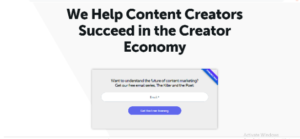
Chewy
When you search for “organic cat food” and “organic dog food,” chewy is among the top 5 organic sites to appear on Google’s SERP. Since its launch in 2011, it has become a go-to for pet supplies.
The product pages are similar to Amazon’s, with reviews, product listings and discount prices that attract customers. Its website copy and content are fully optimized to reach users.
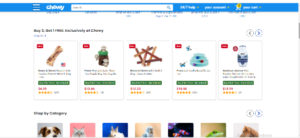
If you study these businesses and other practical examples, it will help build your inbound marketing strategies.
INBOUND MARKETING VS OUTBOUND MARKETING
Inbound and outbound marketing are different approaches to getting marketing leads and results.
Outbound marketing follows the “cold strategy” of seeking out customers to assess their interest in your products/services. These include social media campaigns, calls to direct customers, cold pitches, e.t.c.
However, Inbound marketing, on the other hand focuses on enticing customers towards your business. Like we discussed earlier, these include desirable and informational content for your target audience.
Inbound marketing aims to promote your brand awareness since people tend to buy the brand and not the product.
Another major difference is that inbound marketing builds long-lasting relationships, while outbound is more focused on converting new users.
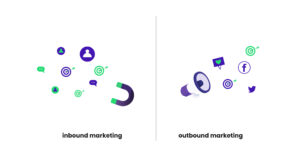
ELEMENTS OF INBOUND MARKETING
There are four (4) key elements you must apply within your inbound marketing startegy Understanding these stages can help you attract the right customers faster. The four elements are; attract, convert, close and delight. HubSpot applies these elements into a business model known as the flywheel.
Before we get to that, let’s look at the elements individually
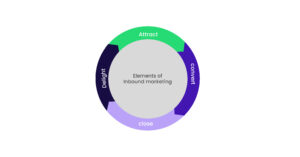
Attract
This is the first element of inbound marketing. It deals with content that pulls the audience’s attention.
You want to pull quality leads (not quantity). And those quality prospects are satisfied customers that are most likely to return.
Ask these questions; “Is my website easily accessible?” “Do I add a lot of relevant keywords to my blog posts?”
Answering these questions and applying the strategies will improve your SEO optimization and help you rank better on Google.
Tools used to attract your target audience include;
- Blogging
- SEO
- Free guides
- E-books, etc.
Convert
After you’ve engaged your visitors, the next step involves obtaining information from your visitors and converting them to leads.
You’ll want to obtain, at least, their email address–after all, a person’s information is valuable data for business growth. Tools in converting prospects to leads are;
- Landing page
- Call to action
- Forms
For example, Mint’s elegant website attracts customers with simplicity. Its homepage also proposes clear concepts and values, including call-to-action, enabling customers to sign up for free or learn more.
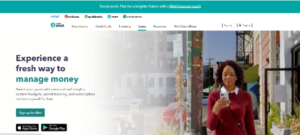
Close
Now that you’ve converted leads, you need to close the deal. In some scenarios, sign-up buttons aren’t enough to get customers to join your community.
One way is to use market automation. That is automated emails that remind customers of their abandoned carts, prompting them to finish their purchase.
It completes the conversion, as 45% of customers open their abandoned carts emails, and 50% of the links are clicked.
Other closing tools include; CRMS and Emails.
Delight
According to HubSpot’s inbound marketing strategy, the last stage involves pleasing your customers even after conversion. You need to reward and provide exceptional services, so your current customers become your company’s promoters.
These contain follow-up emails and calls, thank you messages, discount sales, and more!
THE FLYWHEEL
HubSpot adopted the flywheel as a business model for companies or startups. It illustrates how business owners can improve traffic through exceptional customer experience. With the development of the flywheel, Hubspot restructured the elements to attract, engage and delight.

When you focus on the elements above with appropriate strategies, you build momentum with the flywheel that helps retain customers.
Meanwhile, anything that slows your flywheel, such as miscommunication among team members, causes friction.
Moreover, you can read more about the flywheel here.
INBOUND MARKETING PRINCIPLES AKA SCOPE
With blogs and companies reinventing various marketing strategies, inbound marketing is constantly changing. However, its core principles remain the same. Staying critical with this business ensures your customers receive value and offers that meet their desires and demand.
The principles have been abbreviated to SCOPE and serve as a guide for applying the inbound marketing strategy.
These are the five (5) principles of inbound marketing;
- Standardize
- Contextualize
- Optimize
- Personalize
- Empathize
STANDARDIZE
You have to share your brand values, team processes, and market offers as a business or startup. The standardized principle ensures that your brand story is consistent across all mediums.
The layout of your story is different for all personas and buyers. This doesn’t mean you should get rid of the essence or focus of your brand.
The main idea is to scale your content or story and not the values you offer.
CONTEXTUALIZE:
Contextualization sets a different pace than standardization. While standardization conveys the same messages, processes and results to your entire customers, contextualization entails adapting those messages, processes and results to resonate with target personas at the right time.
Contextualization is really effective when creating content for each of your buyers’ persona. You should mold the delivery of your content to focus on;
Each persona’s weaknesses and needs
The particular point in their buyer’s journey
The medium through which you are distributing your material
Remember, the essential thing here is to “mold.” Instead of falsifying, or exaggerating your story completely—standardization prevents that — you should restructure your story to meet the needs and desires of the audience at any given time.
For example, suppose one of our prospects downloads The Ultimate Guide to Exfoliating. In that case, we know they’ve learned the core concepts of skincare, so we invest in automated marketing and set up a skincare cheat sheet for prospects. In other words, we have a standardized process for delivering contextualized content to our prospects.
OPTIMIZATION
Inbound marketing principles aren’t meant to describe specific actions or procedures in any particular order, although optimization should ideally be the last step in any inbound marketing strategy.
When you’ve created standard messages and processes that appeal to your persona’s specific problems, goals and weaknesses, you may start diving into your data to detect gaps and make adjustments over time.
Regardless of where you are at the inbound marketing activity, you need to gather data to reveal your position in the market and improve your future approach. Suppose you are running an email nurture campaign, for example. In that case, you should measure and analyze your data like open rates and click-through rates to figure out how to mold your subject lines, email copy and content as relevant to your persona as possible.
Like the scientific process, optimization involves formulating a hypothesis to enhance your strategy based on data patterns, testing it and learning from the results. This is an ongoing activity that should continue indefinitely to ensure that your lead generation, prospect engagement, and revenue grows.
PERSONALIZE:
Today’s consumers are bombarded with automated emails, robocalls, and impersonal marketing material. If a corporation can make a prospect feel special, the likelihood of that prospect becoming a customer will increase dramatically.
Personalizing your inbound material gives the impression that you’re cultivating a one-on-one relationship with your audience. Prospects provide information about who they are and what they care about when they fill out a form or interact with your business in any way.
If you can personalize (e.g., use the prospect’s first name in an email) and contextualize (e.g., send the prospect a case study when their web activity indicates that they’re in the evaluation stage of the buyer’s journey) at the same time. In that situation, you’ll have a better chance of successfully engaging with prospects.
EMPATHIZE:
Data easily sway some marketers; still, the human factor must not be overlooked. When you show potential prospects that you understand their problems, that they’re not alone in them, and that you’re able and ready to help them solve their problems, you create an emotional bond with them that’s tough to ignore.
You might be intrigued by the contrast between standardization/optimization’s data-driven nature and humans’ ability to empathize. Empathy is the glue that holds the other four principles together. It’s what allows you to scale and automate in the proper direction – toward, rather than away from, your ideal customers.
Naturally, the goal isn’t to look each potential client in the eyes and make them feel heard. When you scale up, that won’t be possible. The goal is to create a system that allows you to interact with the right people at the right time, allowing you to begin the process of developing a successful, long-term relationship that prioritizes customer satisfaction and, as a result, involves empathy.
INBOUND MARKETING STRATEGIES THAT DRIVE BUSINESS GROWTH
By now, you know the tactics behind inbound marketing and what it takes to work. Let’s dive into inbound marketing strategies for startups.
1. DEFINE YOUR TARGET PERSONA
The first step to a successful inbound marketing campaign is discovering your target audience within your target market.
You need to have an in-depth knowledge of both so that you can learn quickly. In other words, you can’t write informative content without learning about your target audience.
Importantly, one way is to create a Custom Facebook fan page to connect with Facebook users and see who is actually interested in your startup.
2. PRESENT CONTENT AT EACH STAGE OF THE BUYER’S JOURNEY
You have to grow with your audience, and it entails answering the questions that your customers are going to have at each stage of their buyer’s journey.
This is where you apply the principle of contextualization and personalization during content delivery. It helps you to leverage valuable content to retain customers throughout their entire customers’ journey.
According to Demand Metric, companies with blogs generate 67 percent more leads per month than those who don’t.
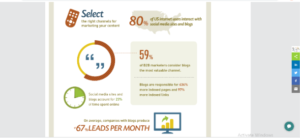
3. SURVEY YOUR CURRENT LEADS
You can heighten the relationship through surveys with your customers’ contact information, such as an email address.
Additionally, you can send out a simple form through Mailchimp or survey monkey and ask a basic question: “What are your current desires?”
The goal is to figure out the problem they are facing so you can create content at each stage.
4. HAVE A RESPONSIVE WEBSITE
Website bugs can slow down the speed and leave your customers irritated. It often leads to a high bounce rate, which is not what you need.
Thus, before you can attract and connect with customers, your website needs to be easy to navigate. Ensure you fix the website bugs for optimization.
You also need to create a mobile-friendly website as most internet searches are made on mobile sites and not desktops. Your site should be on all platforms for secure accessibility and customer satisfaction.
5. CAPTIVATE YOUR AUDIENCE WITH ENTICING HEADLINES
In Neil Patel’s post, he explained the reason why you should have an emotional headline. While headlines don’t represent the entirety of your content, it, however, can dictate the number of clicks you get on the post.
Your headline can prompt three responses;
- Nothing-Your posts get ignored
- Clicks- Your post is introduced
- Share- Your post reach is broadened
In a bid to determine what kind of headlines get the most shares, coschedule analyzed one million headlines and found out in no uncertain terms headlines with more emotional values get the most shares.
Using the Advanced marketing Institute tool, you can analyze your headline. In the end, you want to craft a headline that appeals to your most targeted audience.
6. MAKE YOUR CONTENT VISUAL
Frankly, more discernible your content is, the more it is likely to boost your inbound marketing campaigns. At first, humans act on what they can see. Words can get boring.
Hence, for your content to appeal to your target readers, make sure visuals complement the words/texts.
Include images and charts to make your content more appealing.
7. CONTENT QUALITY MATTERS
Although creating content takes up a small fraction, it is still a pivotal part of inbound marketing. You want to create in-depth and relevant articles backed up with research.
It is not necessarily about the length, as short posts from a website with higher domain authority and backlinks do well. Rather, it is about writing content supported by lots of data and analysis.
When users come across a post with lots of content, they skim through it, looking for the particular word or strategy to quell their curiosity.
For that reason, you need to project as much expertise specifically catered to the audience you want to reach.
You may want to try updating your posts if you are not getting the desired results with quality content. In addition, continuously updating your articles and letting Google know by re-submitting them to its console may increase your ranking and organic search.
Below is a screenshot from Hubspot showing monthly views before and after post update

8. SEO KEYWORD OPTIMIZATION
You have to understand SEO to gain results in today’s online market. It is an essential strategy of inbound marketing that attracts customers.
The most important thing to focus on is your on-page SEO and backlinks to your content. This is achieved through keyword optimization.
Remember not to spam your content with keywords. Search engines usually flag down websites with automated keywords. Instead, use long-tail keywords as they have higher click-through rates.
9. BE CREATIVE WITH STORYTELLING
Like we said, storytelling is the heart of Inbound marketing. Just because you are writing an in-depth article doesn’t mean it needs to be boring.
You want to write articles that represent individuals and tell a story. Using stories solidifies the human aspect of your brand. It improves trust and emotional connection.
Try weaving in stories when talking about your team, product or purpose.
Heck, you can even incorporate storytelling in free guides too.
10. FREE CONTENT DOESN’T HURT
Researches have shown that the word ‘free’ stir a powerful emotion in us.
When it’s time to convert visitors to leads, you need a concrete plan to get their personal contacts and email address.
The best practice that works is offering free content to obtain their contact information.
This is an effective way to get people into your sales funnel and reach out to them more.
Hubspot’s social media trends report is a detailed guide showing you how to drive success in this accelerated age. Even though it’s free, it isn’t necessarily free. We’ll explain. To receive the guides, you need to fill in certain information Hubspot’s use to follow up with you on their products.
11. BUILD SUCCESSFUL EMAIL CAMPAIGNS
For startups, email marketing is necessary for successful inbound campaigns.
Now, is email marketing still effective in 2021?
Positively!
When done right, email marketing provides value to your audience and nurtures leads. This doesn’t include spam; you should never spam your customers! Sending helpful “human” content that enchants your audience, shows them you understand their pain points.
Lastly, email newsletters secure and nurture leads as reported by Content Marketing Institute’s 2020 B2C Benchmarks, Budgets and Trends report.
12. TESTING, TESTING, TESTING
Last but not least is the secret to every profitable marketing–testing.
You need to test and monitor your results at different stages of your business growth. With these results, you can now see what areas need improvement and those that are just right.
If the campaigns don’t work as expected, you should remodel those strategies or try something new.
Running an A/B split-test at intervals is an amazing way to make consistent changes in your marketing strategy.
INBOUND MARKETING TOOLS
Being the forerunner of inbound marketing, Hubspot created a marketing automation platform that earns our top spot for inbound marketing tools.
It’s an all-in-one, free online shop for all things inbound. You get to create, optimize, promote, customize sales funnel and report on end-to-end performance.
Buffer can turn your social media marketing nightmares into an invaluable lead generation channel.
Tools like buffer help schedule your social media content for easy connection with the target demographic.
It also offers personalization and automation, making social media management seamless by saving your time and cash.
This is an email marketing tool that efficiently circulates email newsletters to your customers.
It offers free and paid services. And is ideal for business owners that want to test email templates, keep track of their customers’ actions, and manage sign-up lists, e.t.c.
IT ALL DEPENDS ON YOU
Till this very moment, inbound marketing is the surest way of attracting prospects and converting leads.
To engage customers, you need to “literally” live in their minds. Don’t just be a brand, be their support.
With a high-converting website and bulletproof inbound marketing strategies, you can attain larger business growth.
Which of these strategies will you be implementing? leave a comment below 😊
Don’t forget to subscribe for more insightful posts!
Pretty! This has been a really wonderful post. Many thanks for providing these details.
I appreciate you sharing this blog post. Thanks Again. Cool.
I very delighted to find this internet site on bing, just what I was searching for as well saved to fav